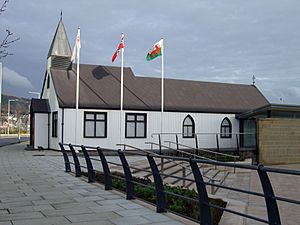Norwegian Church, Swansea facts for kids
The Norwegian Church was a special church built for Norwegian sailors. It was first located in Newport, but later moved to the docklands area of Swansea, Wales. This building is considered a Grade II listed building, which means it's an important historical place.
Contents
History of the Norwegian Church
Building a Home for Sailors
The Norwegian Church building was originally built at Newport Docks. It had two main parts: a Seaman’s Mission on one side and a beautiful Gothic church on the other. Its main purpose was to be a place of worship and support for Norwegian sailors who visited the United Kingdom.
Moving to Swansea
In 1910, the church building was carefully moved from Newport to Swansea. It was set up in a new spot right across from the Sainsbury's supermarket, next to the River Tawe. This new location made it easy for sailors visiting Swansea's busy docks to find their church.
Keeping the Doors Open
By 1966, the Norwegian Seamen's Mission in Bergen, Norway, decided to close the church in Swansea. They told the last minister, Pastor Somerset, to return to Norway. However, a Norwegian man named Eric Benneche, who lived in Swansea, didn't want the church to close. He wrote to the Bishop of Bergen and offered to run the church using money and help from the local Norwegian community. The Bishop agreed and even visited the church to give them the key. Eric Benneche was then allowed to lead services, christenings, weddings, and funerals as a lay pastor.
A New Leader and Final Closure
In 1968, Reverend Vivian James (1927–2011) took over from Eric Benneche. Reverend James had been a missionary in Lapland, Norway, from 1953 to 1967. He preached in both English and Norwegian, keeping the church active for another thirty years. When Pastor James retired in 1998, the Norwegian Church in Swansea was the very last working Seamen's Mission Church. It closed its doors that same year.
A New Life for the Building
As the area around the church was being redeveloped, the building had to be moved again. In 2004, the church was carefully taken apart and then put back together in a new spot. This time, it was moved next to Swansea's Prince of Wales dock. After its move, the building reopened as a jewellery gallery for a while, and later became a nursery. Today, it stands proudly alongside two other historic buildings, the Ice House and J Shed.
See also


